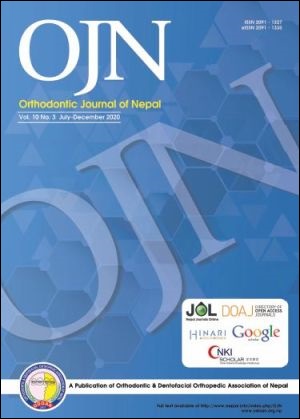A cross sectional study into the use of YouTube™ as a source of patient education in orthodontic treatment risks
DOI:
https://doi.org/10.3126/ojn.v10i3.35489Keywords:
Informed consent, Orthodontic treatment risks, Videos, YouTubeAbstract
Introduction: To investigate the quality of information offered by videos on YouTube™ for those individuals seeking information regarding risks associated with orthodontic treatment. The quality of information was compared the British Orthodontic Society (BOS) patient information leaflet ‘Orthodontic treatment- what are the risks’.
Materials and Method: YouTube™ was searched systematically for videos on orthodontic treatment risks using the terms ‘orthodontic risks’ and ‘braces risks’. Videos were selected based on a strict inclusion and exclusion criteria and demographics recorded. Completeness was assessed using a 8-point score based on the BOS patient information leaflet ‘Orthodontic treatment- what are the risks’. Descriptive statistics and statistical analysis using correlation tests were generated.
Result: 19.2% videos met the specified criteria with 80.8% videos excluded. Videos varied in regards to completeness with the mean completeness score of 3 and only 13% meeting all criteria. The risk of pain and discomfort was most commonly included orthodontic risk 61%. No statistical significance was found for completeness of the video with viewers interaction (R = 0.2665, P=0.219897) viewing rate (R=0.1138, P=0.617326) or length of video (R=0.0062, P= 0.977601).
Conclusion: YouTube™ generally hosts videos with low completeness with regards to orthodontic treatment risks. Therefore, orthodontists should be aware of this resource and caution patients regarding the comprehensiveness of information. In addition to the potentially misleading content which is avail-able within YouTube™ videos
Downloads
Downloads
Published
How to Cite
Issue
Section
License
Copyright © held by Orthodontic & Dentofacial Orthopedic Association of Nepal
- Copyright on any research article is transferred in full to the Orthodontic & Dentofacial Orthopedic Association of Nepal upon publication in the journal. The copyright transfer includes the right to reproduce and distribute the article in any form of reproduction (printing, electronic media or any other form).
- Articles in the Orthodontic Journal of Nepal are Open Access articles published under the Creative Commons CC BY License (https://creativecommons.org/licenses/by/4.0/)
- This license permits use, distribution and reproduction in any medium, provided the original work is properly cited.




